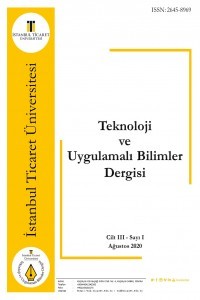TİTANYUM DİOKSİT VE TALK'IN KOMPOZİT MALZEMELERİN ÇEKME DAYANIMI ÜZERİNE ETKİSİ
Epoksi, titanyum dioksit ve talk ile farklı konsantrasyonlarda (ağırlıkça %0, 0,5, 1, 2 ve 4 oranında) dahil edildi ve daha sonra bu karışım elle yatırma işlemi ile karbon fiber ile birleştirildi. Elde edilen kompozitlerin mekanik özellikleri, evrensel çekme testi kullanılarak belirlendi. Çekme test sonuçları, polimer matrisli kompozitlerin mekanik özelliklerinin talk ve titanyum dioksit konsantrasyonlarının bir fonksiyonu olarak arttığını ortaya koydu. Kompozitin en iyi çekme mukavemeti %0.5 talk ve %1 titanyum dioksitten elde edilmiştir. Kompozit üretiminde talkın %1, %2 ve %4 ve titanyum dioksitin %0.5, %2 ve %4 ağırlık oranlarının arttırılması önemli bir farklılık göstermemektedir. Talk ve titanyum dioksit takviyeli kompozit numunelerin çekme testi davranışı, takviye edilmemiş karbon fiber kompozitlere kıyasla daha iyi sonuçlar göstermektedir. Sonuç olarak, bu çalışma, karbon fiber kompozitlerin mukavemetinin nasıl iyileştirilebileceğine dair ayrıntılı bir açıklama sunmaktadır.
Anahtar Kelimeler:
Kompozit, Karbon Fiber, Titanyum Dioksit, Talk, Çekme Testi
EFFECT OF TITANIUM DIOXIDE AND TALC ON THE TENSILE STRENGTH OF COMPOSITE MATERIAL
Epoxy was incorporated with titanium dioxide and talc at different concentrations (0, 0.5, 1, 2, and 4 wt%), and then that mixture was combined with carbon fiber via a hand lay-up process. The mechanical properties of the composites were determined using universal tensile testing. The tensile test results revealed that the mechanical properties of the polymer matrix composites were increased as a function of talc and titanium dioxide concentrations. The best tensile strength of the composite was obtained from the 0.5% talc and 1% titanium dioxide sides. Increasing the weight ratio of talc 1%, 2%, and 4% and 0.5%, 2%, and 4% of titanium dioxide in composite production doesn’t exhibit a significant difference. Tensile testing behavior of talc and titanium dioxide reinforced composite specimens shows better results compared to unreinforced carbon fiber composites. As a result, this study provides a detailed explanation of how to improve the strength of carbon fiber composites.
Keywords:
Composite, Carbon Fiber, Titanium Dioxide, Talc, Tensile Test,
___
- Ahmed, B. F. A. , 2018. Investigation of The Effect of Nanoparticles on adhesion of Single Lap Joints in Composites. University of Gaziantep, Natural and Applied Sciences, M.Sc. Thesis, 89 pages, Gaziantep
- Anaklı, D., Çetinkaya, S., Karakışla, M., Sacak, M. 2018. Synthesis and Characterization of Conductive Poly(o-anisidine)/Talc Composite. Journal of the Faculty of Engineering and Architecture of Gazi University, 403-412 pages
- Andrei, G., Dima, D. & Andrei L. 2006. Lightweight Magnetic Composites for Aircraft Applications. Journal of Optoelectronics and Advanced Materials, Volume 8, 726-730 pages
- Asmatulu, R., Khan W. S., Reddy R. J., Ceylan, M. 2014. Synthesis and Analysis of Injection-Molded Nanocomposites of Recycled High-Density Polyethylene Incorporated with Graphene Nanoflakes. Wiley, 1565-1573.
- Bagatır, T. (2018). Grafen Nanopartikül Takviyesinin Kompozit Malzemelerin Mekanik Özellikleri Üzerindeki Etkisinin Araştırılması. Yüksek Lisans Tezi, Batman Üniversitesi, Batman.
- Bajpai, P. (2017). Carbon Fibre. In Carbon Fibre from Lignin (pp. 17-23). Springer, Singapore.
- Ersoy, B. Sedef, D., Yıldız, A., Gören, R., Elitok, Ö. (2013). Mineralogical and physicochemical properties of talc from Emirdağ, Afyonkarahisar, Turkey. TÜBİTAK Turkish Journal of Earth Sciences, 632-644.
- Jones, R. M. (2014). Mechanics of Composite Materials. CRC Press.
- Karataş, M. A., & Gökkaya, H. (2018). A Review on Machinability of Carbon Fiber Reinforced Polymer (CFRP) and Glass Fiber Reinforced Polymer (GFRP) Composite Materials. Elsevier. Volume 14. 318-426 pages.
- Karol, H.B. (2017). Farklı Takviye Malzemeleri İlave Edilmiş Karbon Fiber Kompozit Malzemelerin Mekanik Davranışlarının Analiz Edilmesi, Trakya Üniversitesi, Fen Bilimleri Enstitüsü, Yüksek Lisans Tezi, 100, Edirne.
- Khan, M. S., & Javed, A. (2020, April). Stress and Deformation Analysis of Helicopter Propeller Made of Composite Material Using Finite Element Analysis. International Bhurban Conference on Applied Sciences & Technology(IBCAST).
- Korotcenkov, G. (2020). Titanium (TIO2) and Its Applications. ELSEVIER, Netherlands.
- Konu, Ö. (2016). Türk Kompozit Sektörü 2016 Yılı Değerlendirilmesi Ve 2017 Yılı Beklentileri.
- Mrazova, M. (2013). Advanced Composite Materials of The Future in Aerospace Industry. Incas Bulletin, 5(3), 139.
- Naveen, P., Goriparthi, B. K., Mayee, M. C. (2019) Evaluation of Mechanical Properties on TiO2/GF Reinforced Nylon66 Composites. Elsevier. 240-245 pages.
- Prasad, V., Joseph, M. A., Sekar K. (2018). Investigation of Mechanical, Thermal and Water Absorption Properties of Flax Fibre Reinforced Epoxy Composite with Nano TiO2 Addition. Elsevier. 360-370 pages.
- Puttaraju, D. G., & Hanumantharaju, H. G. (2022). Finite Element Analysis and Validation of Tensile Properties of Carbon Fiber Reinforced Polymer Matrix Composites. Elsevier. 2800-2807 pages.
- Topcu, I., Gulsoy, H. O., Gulluoglu, A. N., 2019. Evaluation of Multi-Walled CNT Particulate Reinforced Ti6Al4V Alloy Based Composite Creep Behaviour of Materials Under Staic Loads. Gazi University Journal of Science, 286-298.
- Topcu, I., Ceylan, M., Yılmaz, E. B., 2020. Experimental Investigation on Mechanical Properties of Multi Wall Carbon Nanotubes (Mwcnt) Reinforced Aluminium Metal Matrix Composites. Journal of Ceramic Processing Research 21(5), 596-601.
- Yaman, O. F. (2017). CNT Takviyeli Karbon Epoksi Yüzeye Sahip Nomex Çekirdekli Sandviç Yapının Eğilme Özelliklerinin İncelenmesi. Yüksek Lisans Tezi, Afyon Kocatepe Üniversitesi, Afyonkarahisar.
- Yetgin, S. H. 2017. Talk ve EPDM Miktarının PP/Talk/EPDM Kompozitinin Mekaniksel Özelliklerine Etkisinin İncelenmesi. Journal of Science and Engineering. Cilt 19. 295-303.
- Yayın Aralığı: Yılda 2 Sayı
- Başlangıç: 2018
- Yayıncı: İstanbul Ticaret Üniversitesi
Sayıdaki Diğer Makaleler
KÜÇÜK İŞLETMELERİN BÜYÜMESİNDE KURUMSALLAŞMA VE ETKİLERİ
GEOMETRİK DÜZENLEMELERİN YAYA TRAFİĞİ VE ARAÇ TRAFİĞİNE ETKİLERİ (BAHÇELİEVLER ÖRNEĞİ)
Mustafa İslam ÖKSÜZ, Yalçın EYİGÜN
JULİA SETLERİ VE LOJİSTİK HARİTA KULLANILARAK GÖRÜNTÜ ŞİFRELEME
Bahar ARITÜRK, Mustafa Cem KASAPBAŞI
TİTANYUM DİOKSİT VE TALK'IN KOMPOZİT MALZEMELERİN ÇEKME DAYANIMI ÜZERİNE ETKİSİ
Ertunga DİREK, Muhammet CEYLAN
MANDELBROT VE LOJİSTİK KAOTİK HARİTA KULLANILARAK GÖRÜNTÜ ŞİFRELEME
Gülseren KİBAR, Mustafa Cem KASAPBAŞI
Kişiselleştirilmiş Haber Tavsiye Sistemi
RASPBERRY PI TABANLI GİTAR AKORT CİHAZI
Ömer Faruk ACAR, Serhan YARKAN
DOĞA TABANLI ÇÖZÜMLER İLE SÜRDÜRÜLEBİLİR SOKAK PLANLAMASI
